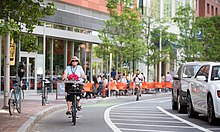User:Oscaroroozco/sandbox
Article evaluation (Urban Planning[1])[edit]
Is everything in the article relevant to the article topic? Is there anything that distracted you?
Yes everything in the article topic of Urban Planning is relevant to the topic. No nothing distracted me from the article.
Is the article neutral? Are there any claims, or frames, that appear heavily biased toward a particular position?
Yes the Article is neutral, there are no particular claims or statement's that seem to have a direct bias.
Are there viewpoints that are over represented, or underrepresented?
No, every header has a substantial amount of information that is equal in all ways, no one is being over represented or underrepresented.
Check a few citations. Do the links work? Does the source support the claims in the article?
Yes all the linked citations work, and the sources do indeed support the claims of the article.
Is each fact referenced with an appropriate, reliable reference? Where does the information come from? Are these neutral sources? If biased, is that bias noted?
Yes, each stated faced is correctly cited with appropriate information. The article is written with many different sources that are reliable, neutral and not biased.
Is any information out of date? Is anything missing that could be added?
After reading the article and clicking through some of the links, they don't seem to be out of date. Everything is relevant and there doesn't seem to be an issue.
Check out the Talk page of the article. What kinds of conversations, if any, are going on behind the scenes about how to represent this topic?
The talk page mentions some issues with a subject on rural planning that has been removed due to some insufficient information. There also seems to be some issues with the article having been moved from a different articles which not has thrown off its history page.
How is the article rated? Is it a part of any WikiProjects?
This article is related because it is the field that we study as Urban and Regional Planning Majors at Cal Poly Pomona. It is part of two separate wiki projects, they are WikiProject Urban studies and planning and WikiProject Architecture.
How does the way Wikipedia discusses this topic differ from the way we've talked about it in class?
It take's a very unbiased view point and simply discusses the facts on the subject of Urban Planning instead of what we want out of the profession.
Add to an Article Assignment (Bike lane)[edit]

A class IV separated bike way (Caltrans) is a bike lane that is physically separate from motor traffic and restricted to bicyclist only.
 | This is a user sandbox of Oscaroroozco. You can use it for testing or practicing edits. This is not the sandbox where you should draft your assigned article for a dashboard.wikiedu.org course. To find the right sandbox for your assignment, visit your Dashboard course page and follow the Sandbox Draft link for your assigned article in the My Articles section. |
- ^ "Urban planning". Wikipedia. 2018-03-28.
Back-road Safety (Draft)[edit]
Back roads, sometimes called rural roads are known to be very unsafe. Back-roads usually have a fatality rate of about two and a half times more then any other road in the United States. A study done in 2015 by TRIP a National Transportation Research Group found that back-roads have a traffic fatality rate of 2.18 deaths per 100 million vehicle miles traveled, whereas all roads combined in the United Sates have a traffic fatality rate of 0.38 deaths per 100 million vehicle miles traveled. Back-roads contribute to 22% of total amount of vehicle miles traveled in the United States, but make up 43% (15,132) of the total amount of vehicle collisions in 2015 (35,092). In 2015 Texas had the highest number of rural non interstate traffic deaths at 1,259 and California in second with 1,219 deaths[1].Back roads are known to have features that make them less safe then a highway, some of the features that are seen in back-roads are narrow lanes, limited shoulders, sharp curves, pavement drop offs, steep slopes, and limited clear zones along roadsides. Given that the majority of back roads were built early in american history, they were often designed with different widths and height restrictions, this makes for unsafe road conditions for modern vehicles and trucks. [2]
Intro[edit]

Many back-roads in North Carolina were created when the states rural transportation system began investing for factories to located outside of urban areas and in rural areas. This created a system of back-roads that allowed for factories to disperse away from busy urban areas. This was done in the late 1940's under Governor Kerr Scott where investment began and was known as the states rural farm-to-market road system. The idea for the farm-to-market road system was to connect farms out in rural areas to the markets in which they sold there produce, this would allow for easy transportation for those who transported there goods to market places. Ultimately these types of roads became state highways or nice quality roads however, the importance of there beginnings is that they began as rural back-roads for agricultural purposes.[1]
Photos of Back Roads[edit]



- ^ Greene, Tyler Gray (2018). "Farm to Factory: Secondary Road Building and the Rural Industrial Geography of Post–World War II North Carolina". Journal of Southern History. 84 (2): 277–310. doi:10.1353/soh.2018.0086. ISSN 2325-6893.
